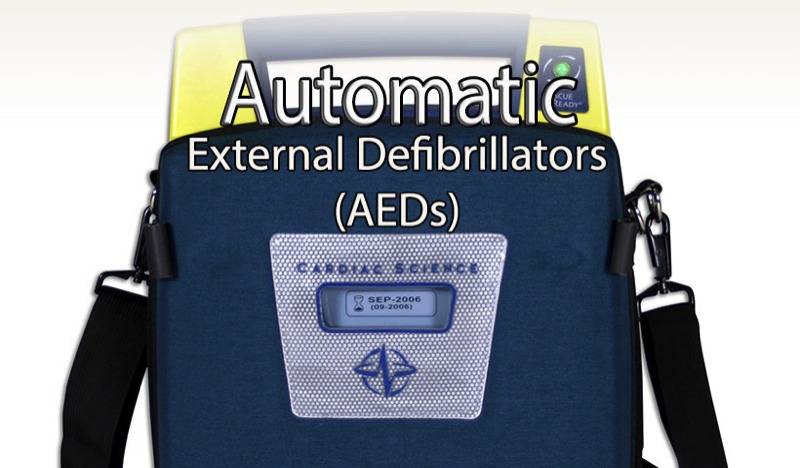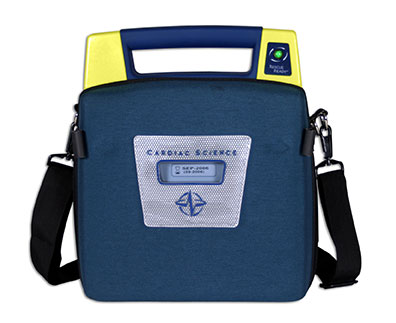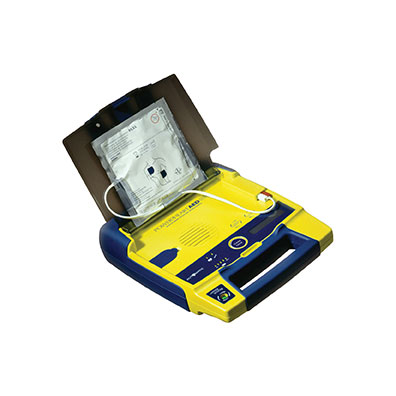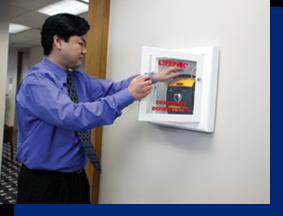

Over the past nine years the District has distributed and maintained Automatic External Defibrillators (AEDs) in each school site and in most facilities. During that time rescuers used the AEDs to save six adults and three students’ lives. Some of the adults were District employees however several were members of the general public that were on campus for a variety of reasons.
In 2004 the School Board approved the funding for the purchase an AED for each school site. In conjunction with this funding, they developed an AED policy that governed the use, maintenance and training requirements for AED use in the District.
Shortly thereafter the Health Services Specialist in collaboration with Risk Management reviewed the Board’s policy and initiated a program that would assist schools to become compliant with the policy. Compliance involved working with schools to designate AED site coordinators and develop and implement training for the AED site coordinators and emergency response teams. This was completed in the years 2006, 2007, and 2008.
Annually, Risk Management reevaluates the status of the current program to reflect changes in Florida’s laws and industry standards. As a result, it was determined that the number AEDs at each location was inadequate and did not meet the American Heart Association’s three minute recommendation. This recommendation states that a responder has three minutes to retrieve the AED and begin cardio-pulmonary resuscitation to afford successful results.
Safety Technicians from Risk Management and Facility Coordinators spent the next year evaluating each of the District’s 185 campuses and determined the need for hundreds of additional AEDs. Based on the evaluations conducted during the previous year it was determined in 2006 that the District would need 600 additional AEDs to meet current standards. The School Board approved the additional funding and the District purchased 600 Cardiac Science AEDs.
The increase of AEDs raised concerns in Risk Management about making sure they were properly maintained. An online program, AED Tracking Program (Database), developed by the District’s IT Department provides a system for tracking AED locations at each school as well as the status of its equipment. This has become an invaluable resource as both AED manufacturers have had several software updates during the past few years. The AED Tracking Program made it easy for District and manufacturer’s representatives to ensure that all AEDs were maintained in a state of readiness.
On April 15, 2009, a District AED helped save Claire Dunlap’s life. At that time, Claire was a 15 year old sophomore varsity softball player for the American Heritage-Delray Stallions. The Stallions had just finished a 5 – 4 win against West Boca Raton Community High and were huddled together after the win. Claire collapsed in the huddle and appeared to be having a seizure. Sarah Donner the trainer for West Boca Raton Community High at the time, came to Claire’s aide, assessed the situation and began to do CPR. Two paramedics were watching another game on a nearby field and came over to assist. One determined that she was in sudden cardiac arrest and that the CPR was not working. He told the trainer to get an AED and she retrieved one from a nearby golf cart. The paramedics put the pads on Claire and it delivered three shocks. The third shock put Claire’s heart back into rhythm.
Claire spent some time in the hospital undergoing a variety of tests and surgery. She emerged eleven days later with an implantable cardioverter defibrillator (ICD) in her chest. An ICD is a small battery operated device that is “implanted in patients who are at risk of sudden cardiac death due to ventricular fibrillation and ventricular tachycardia. The device is programmed to detect cardiac arrhythmia and correct it by delivering a brief electrical impulse to the heart.” Claire said she returned to high school and played softball her junior and senior years with no further incidents. However, since entering the University of Florida (UF) in 2011 the ICD has gone off 3 times, once in 2011, and again in 2012 and 2013.
In the fall of 2014 Claire is entering her senior year at UF and is currently pursuing a degree in advertising. She is active in a lot of campus activities and plays intramural volleyball. During her college career Claire has spoken to a variety organizations both on and off campus as an advocate for CPR and AED training. She is currently president of a philanthropic organization called UF Gator Savers. Each year UF Gator Savers sponsors an on campus event that teaches students CPR, gives them an opportunity to donate blood to the Life South Community Blood Centers and join the bone marrow registry. 690 students were CPR certified during last year’s event.
Claire says after her graduation, she would like to be a manufacturer’s representative for an AED company like Physio Control (formerly Medtronic). Claire noted that she would really like to work with children that are recovering from sudden cardiac events.



